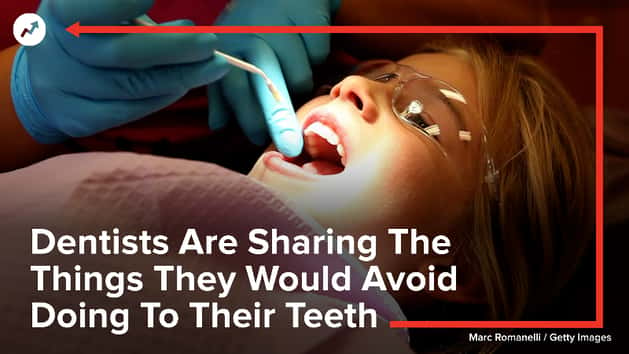TikTok is full of at-home hacks promising a whiter smile in minutes. But do they actually work? According to dentists, the answer is both yes and no. Some are harmless optical illusions that give a short-lived boost, but others can cause irreversible damage to your mouth.
“Most of these shortcuts carry hidden risks,” said Dr. Mark Andrawis, the clinical director and prosthodontist owner of ClearChoice Dental Implant Centers in Roseland, New Jersey. “At first, teeth may look brighter because the stained surface has been stripped away, but repeated abrasion eventually leaves enamel so thin that teeth become permanently sensitive and more vulnerable to decay.”
From trendy store-bought products to DIY concoctions using pantry items, here’s what three experts say you can try in moderation and what you should never put in your mouth.
Purple Color-Correcting Serum
TikTok is obsessed with these violet drops (as seen in the video below), and dentists admit they can work temporarily. “Purple color correctors are generally safe because they rely on pigments rather than peroxide or abrasives,” said Dr. Michael J. Wei, the founder of Manhattan Cosmetic Dentist. “They neutralize yellow tones much like purple shampoo does for hair. Teeth may appear brighter for a few hours, but no actual whitening or stain removal occurs.”
But don’t treat this product like toothpaste. “These serums typically contain a heavy concentration of pigments and excessive use in the oral cavity, which has high permeability, may be concerning,” he added. “Overuse may cause harmless but noticeable staining of gums or tongue.”
Whitening pens
Whitening pens are safe if used as directed, but manage your expectations. “If the whitening pen contains hydrogen peroxide or carbamide peroxide, then it will be effective in whitening teeth,” noted Dr. Jenna Chimon, a cosmetic dentist at Long Island Veneers. “However, they usually will not whiten as well as products that are used in the dental office or other over-the-counter products that create a barrier with the lips. The saliva and lips will wash away the gel from the pens fairly quickly, making the results not as effective and not last as long.”
Still, “they are convenient for touch-ups,” added Wei. “If you have a specific tooth that always looks a little darker, you can spot-apply the pen.”
Plus, not all whitening pens are created equal. “I would look for an ADA seal of acceptance when purchasing in order to ensure safety,” advised Chimon.
Brightening Powder
Dentists were divided over the popular teeth-brightening powder. Some felt it’s a band-aid without lasting benefits, and another said it’s downright dangerous.
“Teeth-whitening powder can be effective for lifting surface stains caused by things like coffee, tea, or wine, but it generally doesn’t change the natural shade of teeth the way professional whitening treatments or peroxide-based products can,” explained Wei. “It more so gives a brightening effect.”
If you do get results you enjoy, don’t expect them to last. “The next time you eat or brush your teeth, the temporary whitening effects will dissipate,” added Chimon.
However, Andrawis cautioned against powders with certain ingredients: “Many whitening powders are unsafe, especially those that are charcoal-based. They are highly abrasive and can wear down enamel, which does not regenerate. Once enamel is lost with excessive use, the result is permanent sensitivity and a greater risk of decay.” By contrast, powders that use a bleaching agent like PAP (phthalimidoperoxycaproic acid) to oxidize stains “may be gentler on the tooth surface, but the research on long-term safety is lacking,” added Andrawis.
Homemade Formulas
TikTok is filled with people claiming miracle results from varied DIY concoctions with items likely already in your pantry. Some can be safe when used cautiously, dentists said, but others can inflict permanent damage on your teeth.
Baking Soda
One of the safer pantry ingredients, baking soda, “can be effective in removing staining on teeth from coffee, tea, and smoking,” said Chimon. “However, it does not contain peroxide, so it does not whiten the teeth from the inside. It only removes surface stains.”
Slightly abrasive, the product should be used sparingly. “The American Dental Association (ADA) generally recognizes it as low abrasion when used for whitening,” added Andrawis. “Overuse or aggressive brushing can still wear enamel.”
Homemade baking soda pastes should be used in addition to a regular dental hygiene routine. “I would not solely use a homemade toothpaste with baking soda because this will not have fluoride,” said Chimon. “Make sure you are using a toothpaste with fluoride in it to help remineralize enamel and prevent cavities.”
Lemon Juice
It may seem innocuous, but lemon juice is one of the most dangerous ingredients TikTokers are putting on their teeth. “Its high acidity can damage enamel,” explained Wei. “This can lead to enamel erosion, increased sensitivity, and a higher risk of cavities.”
Turmeric
Turmeric may have some oral health benefits, but it won’t give you a whiter smile. “Turmeric won’t damage your teeth and could improve gum health, but as a whitening strategy, I would label it ‘ineffective,’” said Wei.
Or worse: “It may actually cause more staining as opposed to whitening teeth,” cautioned Chimon.
Magic Erasers
Perhaps the worst TikTok teeth-whitening “hack” out there, dentists were firm that Magic Erasers should never go anywhere near your mouth.
“Made of melamine foam, they act like fine sandpaper micro-abrading layers of enamel,” said Andrawis. “Scrubbing with them strips enamel permanently and introduces chemicals and microplastics not intended for ingestion.” The many consequences include “lifelong sensitivity, higher cavity risk, and chemical irritation that can cause long-lasting negative effects in the gut.”
